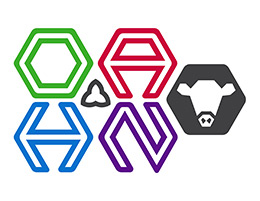Ontario Animal Health Network (OAHN) Bovine Expert Network Quarterly Veterinary Report
Global Surveillance Update:
Influenza A (H5N1) detected in livestock in the United States of America
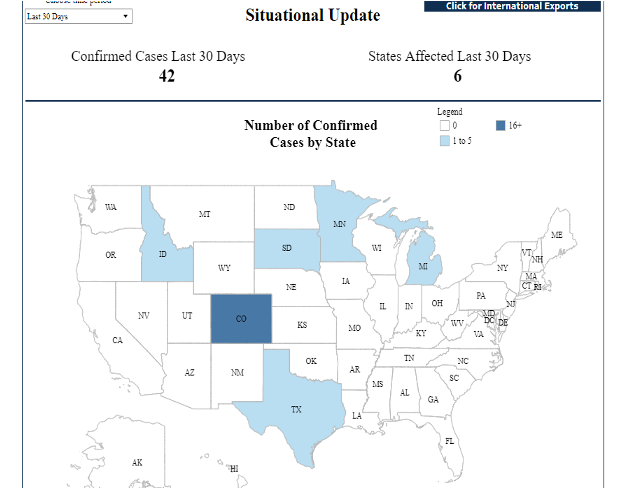
Since the announcement on March 25, 2024 that Influenza A H5N1 (also called Highly Pathogenic Avian Influenza; HPAI) had been detected in raw milk from ill U.S. dairy cattle, there has been an abundance of updates, media articles, and new research published. USDA maintains a situational update of HPAI Confirmed Cases in Livestock Herds including a map on their website (see figure). The detections in dairy cattle are HPAI H5N1 clade 2.3.4.4b, genotype B3.13.
Detections in Other Species
The genotype found in cattle (B3.13) has since been found in domestic poultry flocks, often with links to dairy cattle premises. The same viral genome sequence was found in alpacas in May 2024 that were co-mingled with HPAI affected poultry on a multi species farm. Previously HPAI had been detected in goat kids located on a farm with HPAI affected poultry, however it was unrelated to the dairy event and involved a different virus genotype. USDA has released a document with Information for small ruminant and camelid stakeholders indicating USDA plans to conduct more research to determine the susceptibility of small ruminants including incubation period, viral shedding and clinical signs. There have also been detections in cats and house mice with the same genotype in association with premises with infected cattle and poultry, respectively.
Phylogenetic analysis
Genome sequencing and epidemiology of A(H5N1) is important for understanding the evolution and spread of HPAI among dairy cattle to date. A pre-print genomic analysis released in May 2024 concludes a reassortment event in wild bird populations preceded a single wild bird-to-cattle transmission episode which was followed by local circulation between cattle. This spillover event is estimated to have taken place in December 2023. The researchers identified transmission chains based on genomic similarity and found it was being moved between dairy cattle premises and domestic poultry premises by multiple transmission routes. This publication and another pre-print concludes an existing HPAI genotype underwent reassortment event with another low pathogenic avian influenza (LPAI) virus to produce the B3.13 genotype now circulating in U.S. dairy cattle.
Epidemiological Investigation
The USDA has released two epidemiological reports summarizing the findings of their investigations with affected dairy herds. A National report that included 54% of the known herds at the time of the investigation highlighted that H5N1 spread between States was linked to cattle movements with multi-factorial local spread between dairy herds. Risks for introduction included shared employees, shared transport vehicles and other equipment, and service providers (veterinarians, deadstock pick up, nutritionists, AI technicians, etc).The analysis does not support ongoing independent wild bird introductions into dairy herds.
A report on affected Michigan dairy(n=15) and poultry (n=8) premises found the same genotype (B3.13) on both premises types and supports indirect transfer of virus from the dairy premises to poultry premises. Independent introduction from migratory waterfowl was not supported. Transmission between farms is most likely due to indirect epidemiological links related to normal business operations including shared personnel, visitors, and vehicles. Notably, 9 of the 15 dairy farms reported no cattle introductions prior to becoming positive. Farms were also in close geographic proximity with numerous peri-domestic and wildlife species present and the B3.13 genotype was detected in pigeons, a starling, cats, raccoons, an opossum and foxes on affected premises.
What to do if you observe livestock with clinical signs consistent with Influenza A (H5N1):
- Producers should report clinical signs or suspected illness to their veterinarian immediately
- Veterinarians should contact their local CFIA animal health office if a high degree of suspicion
- Guidelines for veterinarians can be found at:
What to do if you find sick or dead birds or other wildlife on your property:
Report to the Canadian Wildlife Health Cooperative (CWHC) who may arrange for testing
Q1 Bovine Data from the Animal Health Laboratory
A total of 1715 bovine cases were submitted to the AHL during Q1, spanning from February 1, 2024 to April 30, 2024. Of these, 181 submissions had a pathology component, consisting of 76 postmortem cases and 105 send-in cases (including 32 meat inspection cases). Of these, there were 26 reproductive loss investigations, 35 young calves (under 2 months of age), 50 older calves (2 months to 2 years of age) and 38 adult cattle.
Pathology submissions from practitioners included 72 dairy, 63 beef, and 14 where the commodity was not specified, and insufficient clinical history was associated with 11 submissions. Of the submissions from practitioners, a specific diagnosis was not obtained for 26 submissions (7 abortion work-ups, 5 young calves, 4 older calves, 10 adults).
Salmonella
In total, 232 bovine submissions had bacterial culture performed (non-milk), generating 316 cultures. Salmonella spp. were isolated from 5 submissions, representing an estimated 5 premises.
- Salmonella Dublin was isolated from 3 submissions, 2 with no record of previous isolation of this pathogen at the premises. Clinical histories (if provided) reported diarrhea, pneumonia, and sudden death in calves.
- Salmonella Agona was isolated from feces of a 3-year-old animal (no clinical history provided)
- Salmonella Typhimurium was isolated from feces (from enrichment) from a 3-week-old calf with diarrhea, with detection of Rotavirus A and Coronavirus by PCR as well
In total, 13 bovine submissions had Salmonella Dublin PCR performed generating 1 positive result (lung sample from a 3-week-old beef calf, with no clinical history provided).
Bovine Viral Diarrhea Virus (BVDV)
In total, 46 submissions generated 150 samples for BVDV PCR testing, yielding 11 positive samples from two premises (herd testing).
BVDV immunohistochemistry was performed on 1 pathology submission, with negative results.
Getting the Most Out of Diagnostic Submissions
Submission of limited tissue samples for histology and/or ancillary testing can significantly hinder a diagnostic investigation and result in failure to reach a diagnosis, and insufficient clinical history can preclude valuable integration of results with the overall clinical picture. In order to maximize the chances of reaching a diagnosis and gain insight and actionable information, practitioners are encouraged to routinely collect a wide array of formalin-fixed AND fresh/frozen tissues to be submitted along with a succinct and informative clinical history. Not sure what samples to submit? The AHL has diagnostic plans available at https://www.uoguelph.ca/ahl/diagnostic-plans/diagnostic-plans-bovine, including tailored plans for abortion, diarrhea, neurologic disease, respiratory disease and unexpected death, each of which can be printed and consulted regularly when performing on farm necropsies. If you find yourself left with a question regarding sample collection or submission, always feel free to reach out the AHL directly for guidance!
| About This Report |
| This summary has been compiled by Dr. Rebecca Egan, Animal Health Laboratory (AHL) from diagnostic submissions to the AHL Guelph and Kemptville locations. |
Update on Condemnations at Ontario Abattoirs
Q1 2024 (February-April) provincial abattoir slaughter/condemnation highlights
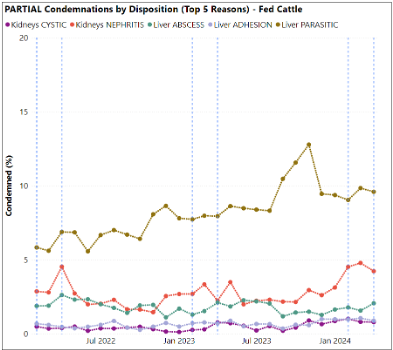
Fed cattle
- Top 3 full carcass condemnation reasons this quarter were septicemia, pleuritis, and peritonitis
- Livers condemned as parasitic remains the top reason for partial condemnations since February 2022
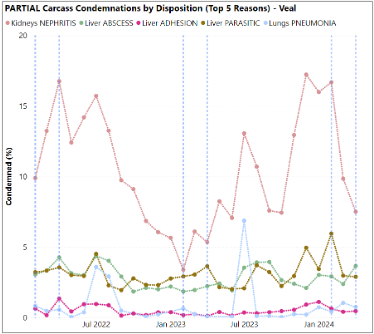
Veal
- Top 3 full carcass condemnation reasons this quarter were septicemia, pleuritis, and peritonitis
- Kidneys condemned due to nephritis remains the top partial condemnation reason since February 2022, though decreased throughout the quarter
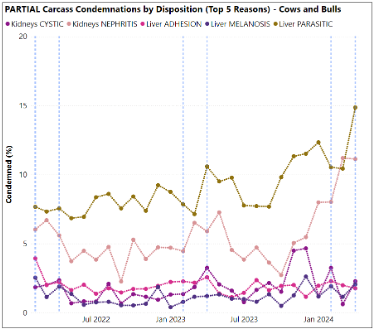
Cows/bulls
- Top 3 full carcass condemnation reasons this quarter were peritonitis, endocarditis, and pleuritis
- The percent of partial condemnations due to parasitic livers and kidneys with nephritis exceeded levels recorded since February 2022
Digital Dermatitis in Feedlot Cattle
Digital dermatitis (DD) is a growing concern in Ontario feedlots but previously has only been studied in the Ontario dairy industry. An OAHN survey was initiated to investigate the management practices that are used by Ontario feedlots in the prevention and treatment of DD. The survey response rate was lower than hoped for, however there are still some interesting findings indicating producers are struggling with this issue and need preventative protocols and support.
- Survey respondents (n=14) included all production stages; all respondents had cattle in the finishing stage. All were feeding traditional beef breeds; half had beef on dairy crosses.
- All respondents sourced cattle from Western Canada, with the second most common source being Southern Ontario. Other sources include the United States, Quebec or Eastern Canada, Eastern Ontario and Northern Ontario. All the respondents sourced from direct sales, and most of the respondents also sourced from auctions or special sales.
- The most common housing was 1) indoor pack with no scrape alleys and 2) indoor pack with scrape alleys. Most respondents indicated that they clean/scrape out the pack weekly.
- Most respondents had observed DD on their farm. Producers reported decreased weight gain in cattle with DD, and many reported decreased live weight at slaughter or having to rail early.
- Most farms were equipped with a chute where lame cattle could be examined. Less than half of the respondents reported routinely picking up and examining the feet of cattle suspected to have digital dermatitis to identify the cause of lameness and potentially apply treatment.
- The most common biosecurity practice in the prevention of DD was the use of footbaths (half of the respondents). Most of the respondents targeted their footbath use upon arrival and between barn moves. The most common footbath solutions that producers used were copper sulfate and formaldehyde. Although there is limited efficacy reported in literature, some producers also used antibiotics (such as tetracycline, tylosin or other) and soap.
- Producers typically spent up to an hour per week pulling and treating cattle for DD.

Bits and Bites
- In May, 2024, three steers on a Stearns County farm in Minnesota tested positive for rabies. A total of 4 steers showed clinical signs consistent with rabies including being down, drooling, and lack of coordination. One animal showed excessive vocalization and aggression. The herd was placed under quarantine and contacts on the farm received post-exposure prophylaxis. In April, a pregnant cow in Rock County, Minnesota and a calf in Pipestone County, Minnesota also tested positive for rabies bringing the Minnesota bovine total to 7 rabies cases since 2023. It is believed cattle were likely exposed to a rabid skunk given the local rabies risk in Minnesota.
***Ontario veterinarians looking for information on how to assess and respond to rabies risk can find it at Rabies: information for veterinarians | ontario.ca
- The Animal Health Diagnostic Lab in New York reported a large outbreak of clostridial myositis (black leg) in dairy heifers aged 7-9 months. The animals first presented as weak, later becoming recumbent and died rapidly or were euthanized. Affected animals had some swelling in one or more limbs. Postmortems revealed severe, multifocal, generalized, acute emphysema, hemorrhage and edema of the skeletal muscle. Diagnosis was made by positive growth of Clostridium chauvoei and positive C. chauvoei fluorescent antibody stain on skeletal muscle tissue. No recent injections or common source of bruising was identified in the 3 affected pens. A recent new feed purchase was noted. Heavily contaminated feedstuffs can result in spore translocation across the gut barrier, into the bloodstream.
- CIPARS has released new interactive data visualizations for farm antimicrobial use data which describe antimicrobial use by species, province, route, drug class and category of importance as well as veterinary antimicrobial sales reporting and antimicrobial resistance.
Other Resources to Check Out
Canadian Animal Health Surveillance System (CAHSS) https://cahss.ca/
A network of animal health surveillance networks in Canada – the CAHSS website includes a variety of resources. Some highlights include:
- Red Meat Yearly Slaughter – CAHSS Federally Inspected Slaughter Dashboard
- Includes an overview of federally inspected slaughter data by species and year
- Biosecurity documents related to H5N1 Detections in Cattle in the U.S.A
- Biosecurity recommendations for Canadian Herds
- Biosecurity recommendations for service providers
Help us help you!
Have an idea for an infographic you’d like to see, or a podcast you’d like to hear? Email oahn@uoguelph.ca to let us know!
FEB 2024 – APR 2024
